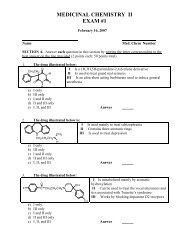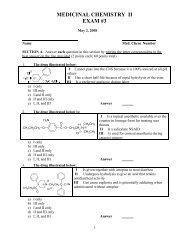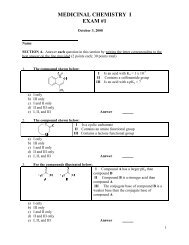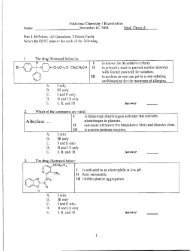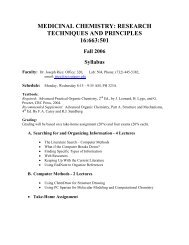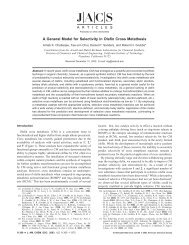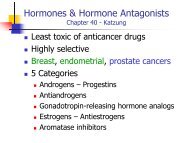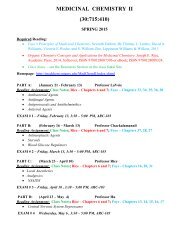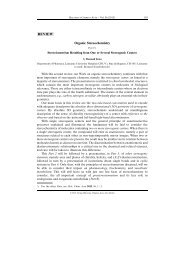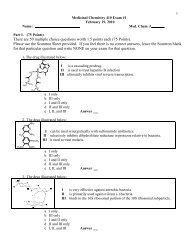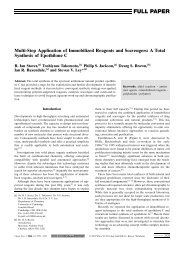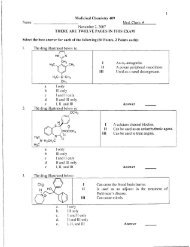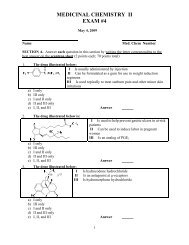Baldwin's Rules - Department of Medicinal Chemistry
Baldwin's Rules - Department of Medicinal Chemistry
Baldwin's Rules - Department of Medicinal Chemistry
Create successful ePaper yourself
Turn your PDF publications into a flip-book with our unique Google optimized e-Paper software.
Chemical Reviews REVIEW<br />
process that can only occur for exocyclic closure. The regioselectivity<br />
<strong>of</strong> the electrophilic closures <strong>of</strong> primary and secondary<br />
carbenium ions depends upon the substitution <strong>of</strong> the alkyne,<br />
directing nucleophilic attack via the buildup <strong>of</strong> partial positive<br />
charge. Cyclization is not observed for tertiary carbocations in<br />
the presence <strong>of</strong> weak nucleophiles (Scheme 8).<br />
3.2. 4-exo versus 5-endo Cyclizations<br />
Figure 14<br />
Competition in this pair <strong>of</strong> cyclizations is fundamentally<br />
different from other pairs discussed in this work where the<br />
thermodynamic driving forces for the two competing cyclizations<br />
are similar (both products are either strained (3-exo/4-endo) or<br />
free <strong>of</strong> strain (5-exo/6-endo)) and where, in the case <strong>of</strong><br />
nucleophilic and radical closures, there is usually a clear kinetic<br />
preference for the exo path. However, for the 4-exo/5-endo pair,<br />
one <strong>of</strong> the products (exo) is much more strained than the other<br />
(endo). As the result, the endo cyclization is much more<br />
exothermic, and the competition between 4-exo and 5-endo<br />
closure, onto both olefins 77 and alkynes, becomes delicately<br />
balanced due to the thermodynamic contributions selectively<br />
facilitating the endo closure (see section 2.6).<br />
This competition also represents an interesting unresolved<br />
question regarding stereoelectronic factors in organic reactions.<br />
While the product <strong>of</strong> the stereoelectronically favorable 4-exo-dig<br />
closure suffers from considerable strain, the formation <strong>of</strong> a<br />
five-membered ring, via a nucleophilic closure, has to overcome<br />
stereolectronic factors which disfavor anionic endo-dig cyclizations<br />
(Figure 6).<br />
3.2.1. Radical Cyclizations (Table 9). Whereas both 3-exoand<br />
4-endo-dig radical closures were found to be endothermic<br />
processes with no examples in the literature (vide supra), 4-exo<br />
radical cyclization <strong>of</strong> the parent radical is essentially thermoneutral<br />
(ΔE r ≈ 0), and 5-endo closure is significantly exothermic<br />
(Table 10). Remarkably, the calculated activation barriers suggest<br />
that the 4-exo-dig closure should still be capable <strong>of</strong> competing<br />
kinetically with the much more exothermic 5-endo-dig closure. For<br />
the parent carbon-centered radical, the 4-exo and 5-endo barriers<br />
are very close. 78<br />
While 4-exo-trig cyclizations are relatively well-documented, 79<br />
the literature examples <strong>of</strong> regioselective 4-exo-dig radical closures<br />
are scarce. 15 A single example <strong>of</strong> 4-exo-dig closure <strong>of</strong> an alkyl<br />
radical (motif A, Table 9) has been observed experimentally<br />
(3.026, Scheme 9). This transformation has been reported by<br />
Malacria et al. as part <strong>of</strong> radical cascade leading to the formation<br />
<strong>of</strong> bicyclo[3.1.1]heptanes. 80,81 The overall yield for the product<br />
is 85% yield after reaction with MeLi, serving as a lower boundary<br />
estimate for the 4-exo-dig step. The surprising efficiency <strong>of</strong> this<br />
unprecedented transformation has been attributed to the fast<br />
intramolecular trapping <strong>of</strong> the exocyclic vinyl radical via 1,6-H<br />
transfer from a SiCH3 moiety.<br />
The only reported literature attempt <strong>of</strong> a 5-endo-dig cyclization<br />
<strong>of</strong> a simple alkyl radical led to quantitative formation <strong>of</strong> acyclic<br />
reduced product 3.030 (Scheme 10). 82<br />
Alabugin and co-workers investigated the apparent discrepancy<br />
between the Baldwin rules and the lack <strong>of</strong> an efficient<br />
Table 9. Literature Examples <strong>of</strong> 4-exo/5-endo-dig Radical Closure<br />
with Respect to the Environment <strong>of</strong> the Radical Center b<br />
a Outside scope <strong>of</strong> Baldwin <strong>Rules</strong>. b x marks denote gaps in the literature.<br />
Motif structures are given in Scheme 1, and motifs D G are unknown.<br />
Table 10. Activation, Reaction, and Intrinsic Energies (kcal/mol)<br />
for the Parent (A), (σ-vinylexo, B), (σ-vinylendo, C), and (Callylendo3,<br />
H) 4-exo- and 5-endo-dig Radical Digonal Cyclizations c<br />
a B3LYP/6-31+G(d,p) and M05 2X/6-31+G(d,p) levels, ref 24.<br />
b B3LYP/6-31G** level, ref 83. c Ring-closing bonds are shown in red.<br />
M dx.doi.org/10.1021/cr200164y |Chem. Rev. XXXX, XXX, 000–000



